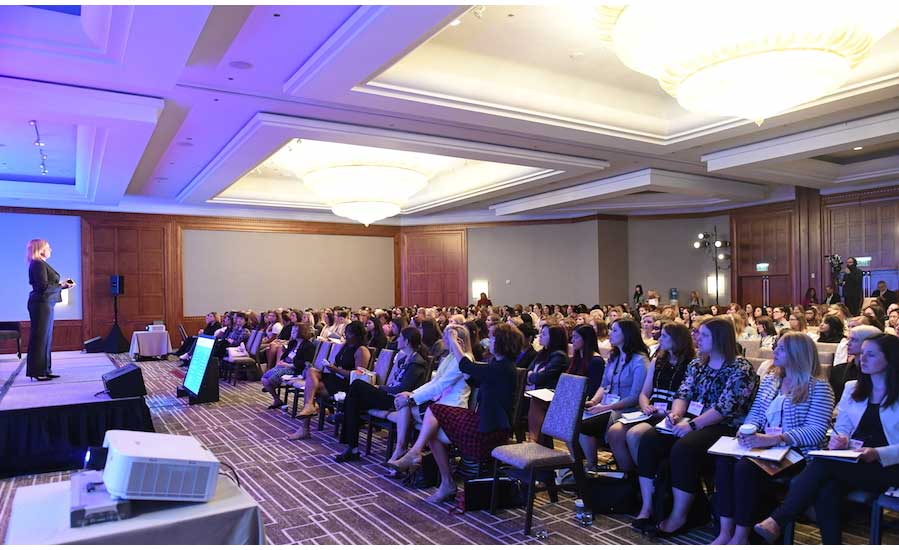Noting their contributions to "the power of the purse" for their employers, women in construction are pushing for parity in compensation, which continues to lag behind that of male peers.
Despite numerous studies that show the business value of diverse management and professional teams, a gender-based wage gap still dogs women in the business world, said Carey Smith, president of the federal business unit of Parsons Corp. She made those comments to nearly 400 attendees at ENR's Groundbreaking Women in Construction conference, held May 2-3 in San Francisco.
According to Smith, the gender pay gap in construction—with women earning 93¢ for every male dollar—is narrower than the business average of 82¢ per dollar, "but it's not where we need to be."
Smith noted the "amazing statistic" that companies diversified by gender and ethnicity outperform peers by 15% and 35%, respectively, citing research by consultant McKinsey. "According to the study, womens' equality could add $12 trillion to global economic growth," she told attendees at the event, which is co-sponsored by law firm Peckar & Abramson.
A panel of mixed-gender professionals outlined examples of how the "diversity dividend" works in their companies.
Lisa Mingoia, corporate counsel at Skanska, said the diversity of its presentation team was a factor in its win of a key construction role on the multibillion-dollar renovation of LaGuardia Airport in New York City, set for completion in 2021.
"Having a female executive is the single most important way to drive organizational change," said Laura Abrahamson, AECOM senior vice president and associate general counsel, adding that 45% of the giant AE's staff is female and that women make up 43% of its leadership.
"Intentionalness sets AECOM apart," she told attendees.
Jon Michael Pardo, chief human resource officer at Spain-based contractor Dragados, echoed that contention, noting the diversity strength in its team that successfully competed for construction of a new Chesapeake Bay tunnel.
"Europeans have a better model for women in executive roles," he claimed. "In the U.S., we're getting there."
Pay Gaps in Industry Sectors
Even so, presenters noted evidence of pay gaps in industry sectors. A 2015 study of 2,200 male and female structural engineers revealed a $52,000 gap at the principal level, despite faster advancement of women at lower levels, said Angie Sommer, an associate at ZFA Structural Engineers who co-chaired the survey project, which also looked at practitioner engagement.
She said a more detailed study of the compensation gap results will be conducted this year but noted the difficulty of finding competitive compensation data. "It's always been a taboo subject," she told attendees.
Priya Kapila, compensation practice leader at industry management consultant FMI, noted the need for "objective measures" such as a company-wide pay equity analysis, and a look at issues related to "comparable worth" of job roles.
She also pointed to trends that show disparities resulting from different gender-based negotiating approaches and management aspirations, emphasizing that "recognizing high performers" is critical.
Pointing to the Obama administration push to level the compensation playing field through order and regulation, Kellie McElhaney, a consultant and professor in the University of California, Berkeley business school who has studied gender workplace trends, noted changes to come in the Trump government.
The president, in late March, revoked a 2014 Obama order that required wage transparency for workers of federal contractors and barred forced arbitration clauses in sexual-harassment settlements.
"I have lost faith in the government taking this on," she said, although noting that activist investors and even municipal governments are stepping up to help "de-bias" corporate processes.
Parsons Corp. executive Smith said the administration promise of a huge infrastructure program would boost oportunities for women project leaders and business owners in construction. But Smith noted the funding battles that will delay it well into 2018 and other market growth impacts from "trade crises" and labor shortages.
For now, Smith called on industry CEOs to "take personal responsibility to drive diversity" in recruiting and retention through efforts such as targeted project assignments, mandated leadership training for diverse candidates and creation of affinity groups "as long as they don't become social organizations."





